Analysis of the Dependence of the Apparent Sound Reduction Index on Excitation Noise Parameters
Abstract
1. Introduction
2. Materials and Methods
2.1. Realization of the Experiment
- Given the number of performed measurements (in the order of hundreds), a constant state of the assessed building was ensured. Measurements were conducted over several weeks.
- The location of the measuring points was the same for all measurements in the source and receiving room.
- Background noise did not affect the measurements. This was repeatedly checked for all measurements. The choice of the building structure location was made with regard to this requirement.
- Measurement chain was calibrated before and after each measurement.
- For each measurement, sound pressure levels in the source and receiving room, background noise, and reverberation time in the receiving room were measured.
- The building structure was homogenous (no structural openings, no media distribution, and no use of different building materials). Its construction was made of one type of material (brick—thickness 300 mm, plaster—15 mm), and it was built with emphasis on uniform properties over the entire surface of the structure. The partition under consideration was connected structurally to the side walls without the possibility of lateral sound transmission between the rooms.
- In both rooms, double-glazed windows with soundproof double glazing were installed, which prevented the transfer of acoustic energy between the rooms. A double-layer door was also installed. Perfect closing of windows and doors has been ensured during the measurement.
- For all set combinations of measurements (factors B and C), ten sets of measurements were performed, which is a statistically significant number.
2.2. Evaluation Methods
2.2.1. DOE Methods
2.2.2. Regression and Correlation Analysis
3. Results and Discussion
- Determine the effect of factors on the apparent sound reduction index of building partition using the method of planning experiments;
- Analyze the dependence of the extent of the apparent sound reduction index on the input parameters (frequency and excitation interval) for both types of noise in the monitored frequency intervals;
- Analyze the dependence of the extent of apparent sound reduction index on the input parameters (frequency, excitation interval, type of noise) in the monitored frequency intervals.
3.1. Monitoring the Influence Of Factors On The Apparent Sound Reduction Index—DOE Method
3.2. Regression Model I
3.3. Regression Model II
4. Conclusions
- Regression Model I, which was focused on assessing the effect of frequency and excitation interval on the apparent sound reduction index, shows the independence of the results from the excitation interval for frequencies above 120 Hz. This means that, in the case of routine assessments (for example, in the indicative determination of the airborne sound insulation of building structures), it is not important to pay attention to the intensity of sound field excitation in the source room, while the basic recommendations given in technical standards must be observed.
- Regression Model II, which was focused on assessing the effect of frequency, excitation interval and type of noise used on apparent sound reduction index, shows the independence of the results from the type of noise used in two frequency intervals (Interval II, Interval III). Again, the independence of results from the excitation interval for frequencies above 120 Hz and a significant dependence at frequencies up to 120 Hz are confirmed, which is evident from the scatter plot of residues for both types of noise (see Figure 8). The impact of frequency on the results of determination of airborne sound insulation of building structures is significant in all frequency intervals. On the other hand, in the area of low frequencies (below 100 Hz, Interval I), the results of determining the apparent sound reduction index are significantly affected by the values of the investigated frequency interval and the used excitation interval. The influence of the noise type also manifests itself in this frequency interval.
Author Contributions
Funding
Conflicts of Interest
References
- Stephens, D. Measurement of sound insulation with a sound level meter. Appl. Acoust. 1976, 9, 131–138. [Google Scholar] [CrossRef]
- Hongisto, V. Airborne Sound Insulation of Wall Structure—Measurement and Prediction Methods. Doctoral Dissertation, Helsinki University of Technology, Helsinki, Finland, 2000. Available online: https://core.ac.uk/download/pdf/80701311.pdf (accessed on 20 November 2020).
- Reinhard, O.; Jian, K. Airborne sound insulation in terms of a loudness model. Appl. Acoust. 2014, 85, 34–35. [Google Scholar]
- Roozen, N.B.; Leclere, Q.; Urban, D. Mobility based measurement of the airborne sound insulation R at low frequencies. In Proceedings of the 26th International Congress on Sound and Vibration, Montreal, QC, Canada, 7–11 July 2019. [Google Scholar]
- Dlhý, D.; Tomašovič, P. Sound insulation determination of door. Adv. Build. Constr. Mater. II 2014, 1057, 215–222. [Google Scholar] [CrossRef]
- Čulik, M.; Jochim, S.; Ondrejka, V. Sound insulation of partition wall and ceiling in panel timber frame structure. Akustika 2019, 31, 145–152. [Google Scholar]
- Bonfiglio, P.; Fausti, P. Determination of sound reduction index by impulse response measurements. Acustica 2004, 14, 8. [Google Scholar]
- Erofeev, V.I. Sound insulation properties of sandwich panels. IOP Conf. Ser. Mater. Sci. Eng. 2020, 896, 012005. [Google Scholar] [CrossRef]
- Piana, E.A. Method for determining the sound reduction index of precast panels based on point mobility measurements. Appl. Acoust. 2016, 110, 72–80. [Google Scholar] [CrossRef]
- Reboul, F.; Pou, J.M. Airborne sound insulation in buildings—Calculation of uncertainty of the weighted apparent sound reduction index, R’w, according to the Monte Carlo methods. In Proceedings of the 17th International Congress of Metrology, Paris, France, 21–24 September 2015. [Google Scholar]
- Balan, O.; Moldoveanu, F.; Morar, A.; Asavei, V. Experiments on Training the Sound Localization Abilities: A Systematic Review. Let’s build the future through learning innovation 2014. In Proceedings of the 10th International Scientific Conference on eLearning and Software for Education, Bucharest, Romania, 24–25 April 2014; Volume 2, pp. 34–41. [Google Scholar]
- Moreno, A. Factors influencing dB (A) ratings for sound insulation: Incident noise spectrum and shape of the transmission loss curve. J. Sound Vib. 1984, 97, 337–348. [Google Scholar] [CrossRef]
- Arjunan, A.; Foteinou, A. A comparative study on the acoustic behaviour of free-standing curved and flat single panel screens in an open-plan enclosed environment. In Proceedings of the 46th International Congress and Exposition on Noise Control, Hong Kong, China, 27–30 August 2017. [Google Scholar]
- Buratti, C.; Moretti, E.; Vergoni, M. Sound insulation performances of windows: evaluation of the influence of different traffic noise spectra in laboratory and field measurement. In Proceedings of the 17th international congress on sound and vibration, Cairo, Egypt, 18–22 July 2010. [Google Scholar]
- De La Prida, D.; Pedrero, A.; Navacerrada, M. Ángeles; Díaz-Chyla, A. An annoyance-related SNQ for the assessment of airborne sound insulation for urban-type sounds. Appl. Acoust. 2020, 168, 107432. [Google Scholar] [CrossRef]
- Marouf, S.S.; Bell, M.C.; Goodman, P.S.; Neasham, J.; Neasham, J.; Namdeo, A.K. Comprehensive study of the response of inexpensive low energy wireless sensors for traffic noise monitoring. Appl. Acoust. 2020, 169. [Google Scholar] [CrossRef]
- Regadío, A.; Tabero, J.; Prieto, S.S. Impact of colored noise in pulse amplitude measurements: A time-domain approach using differintegrals. Nucl. Instrum. Methods Phys. Res. Sect. A Accel. Spectrometers Detect. Assoc. Equip. 2016, 811, 25–29. [Google Scholar] [CrossRef]
- Kaneda, Y. Noise reduction performance of various signals for impulse response measurement. J. Audio Eng. Soc. 2015, 63, 348–357. [Google Scholar] [CrossRef][Green Version]
- Lumnitzer, E.; Andrejiova, M.; Bodnárová, A.G. Verification of the impact of the used type of excitation noise in determining the acoustic properties of separating constructions. Measurments 2016, 78, 83–89. [Google Scholar] [CrossRef]
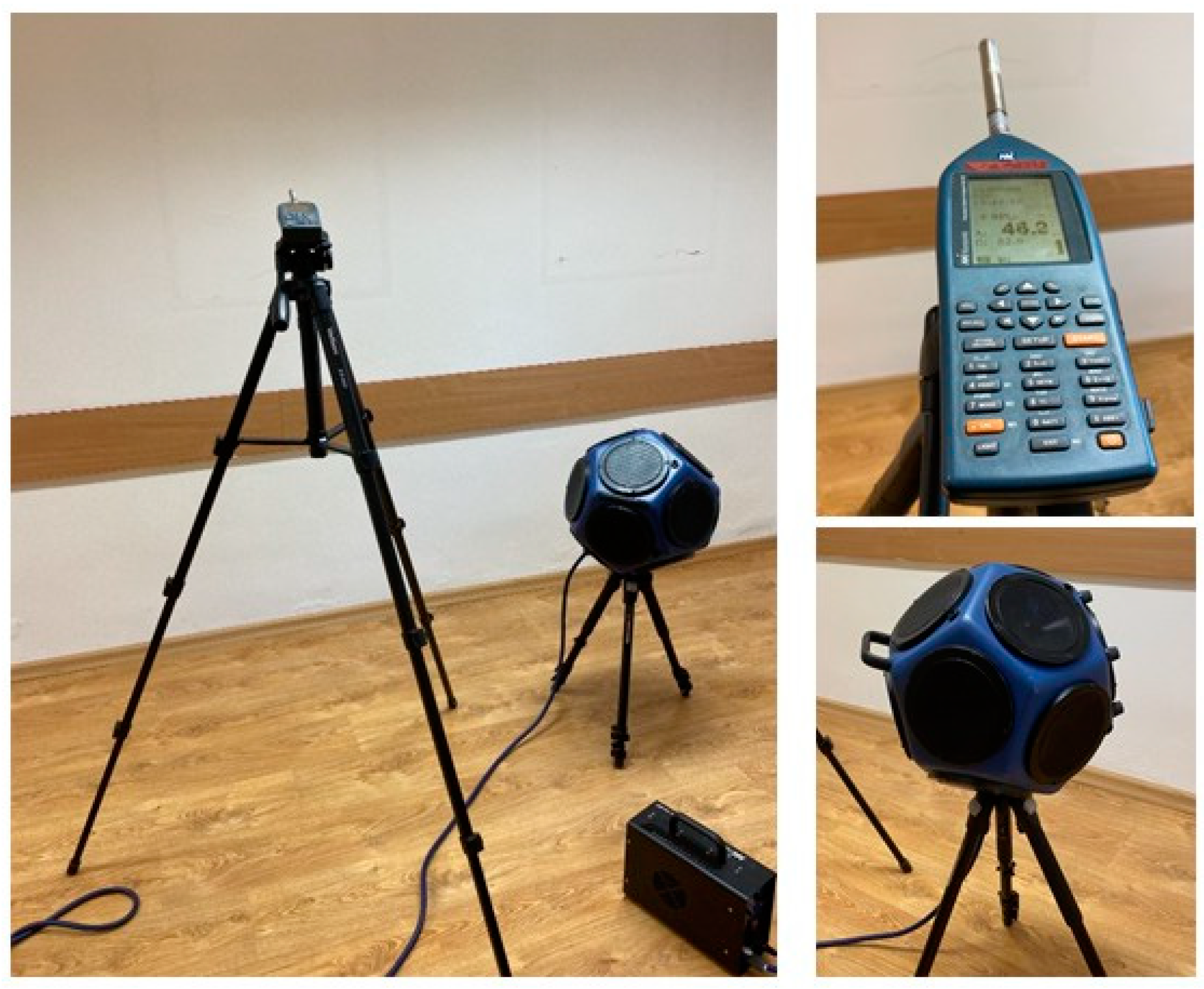
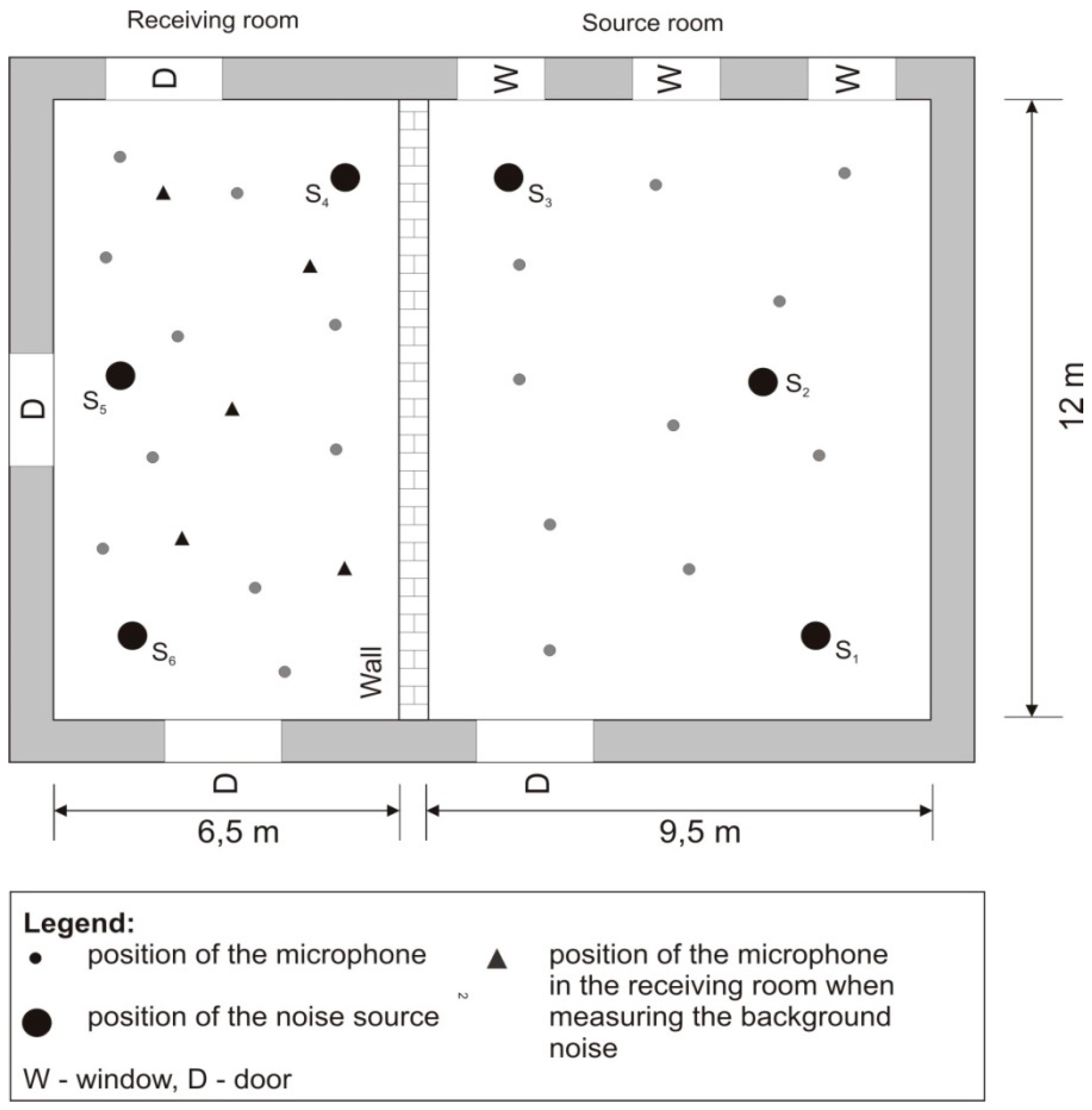

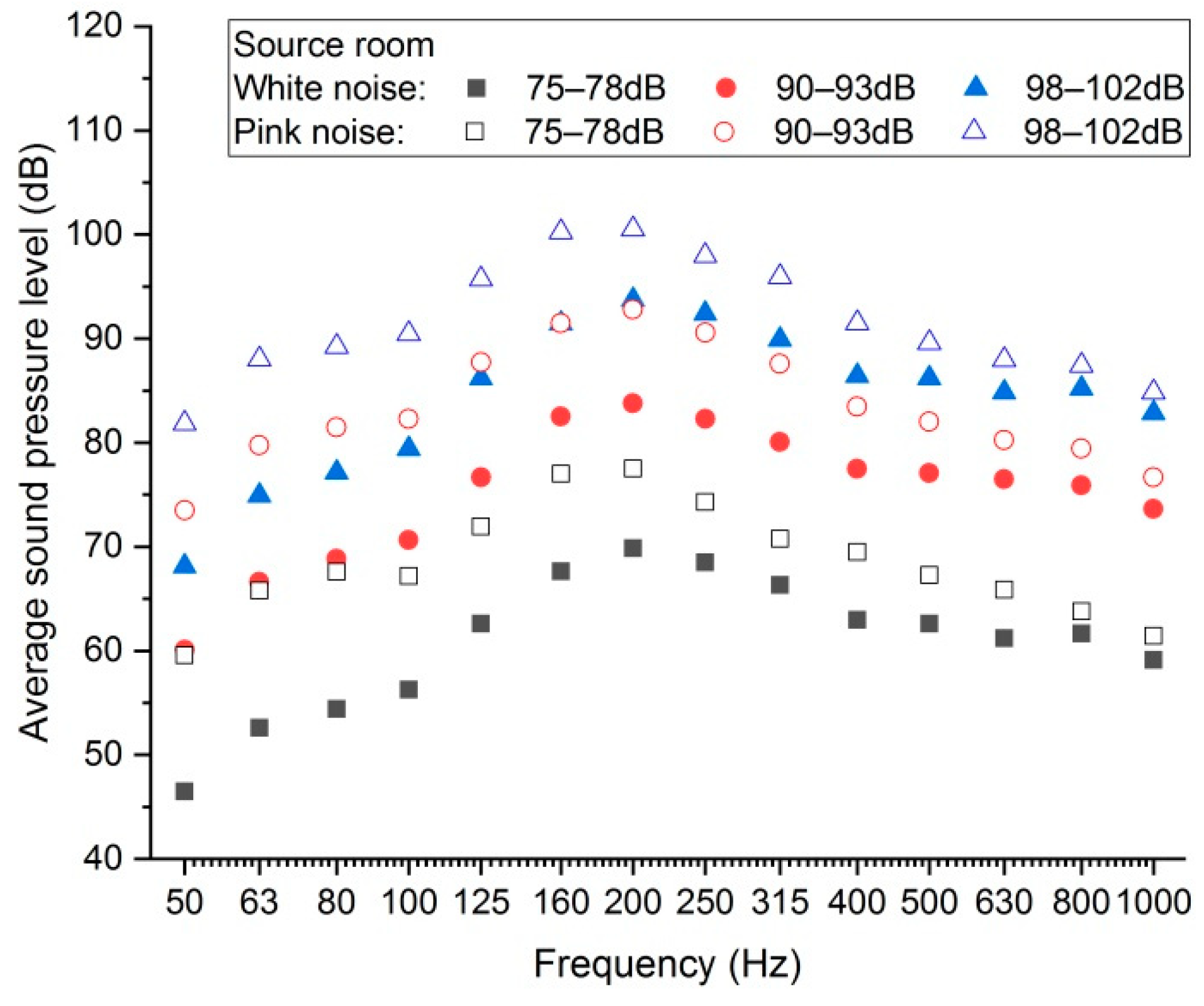

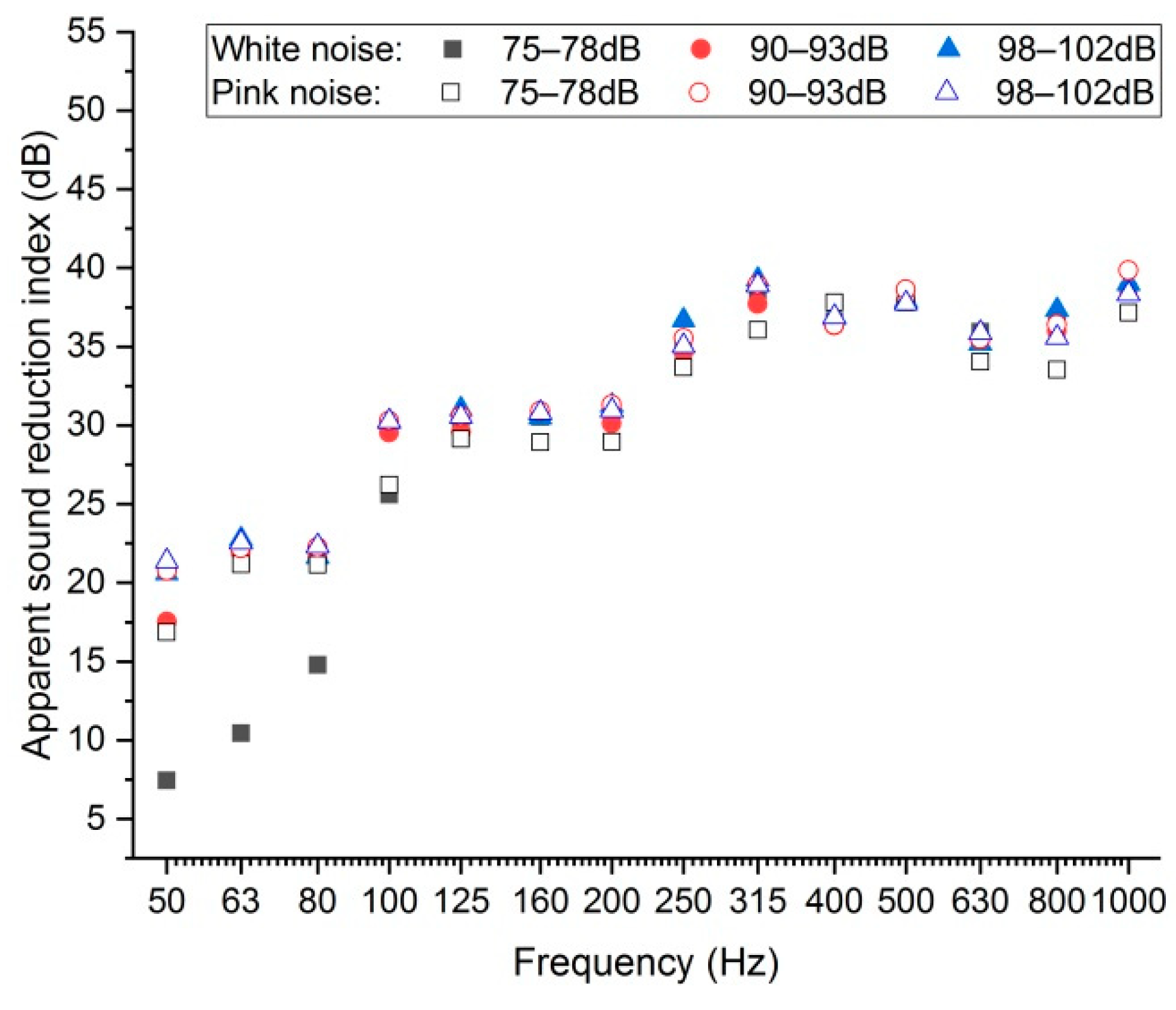
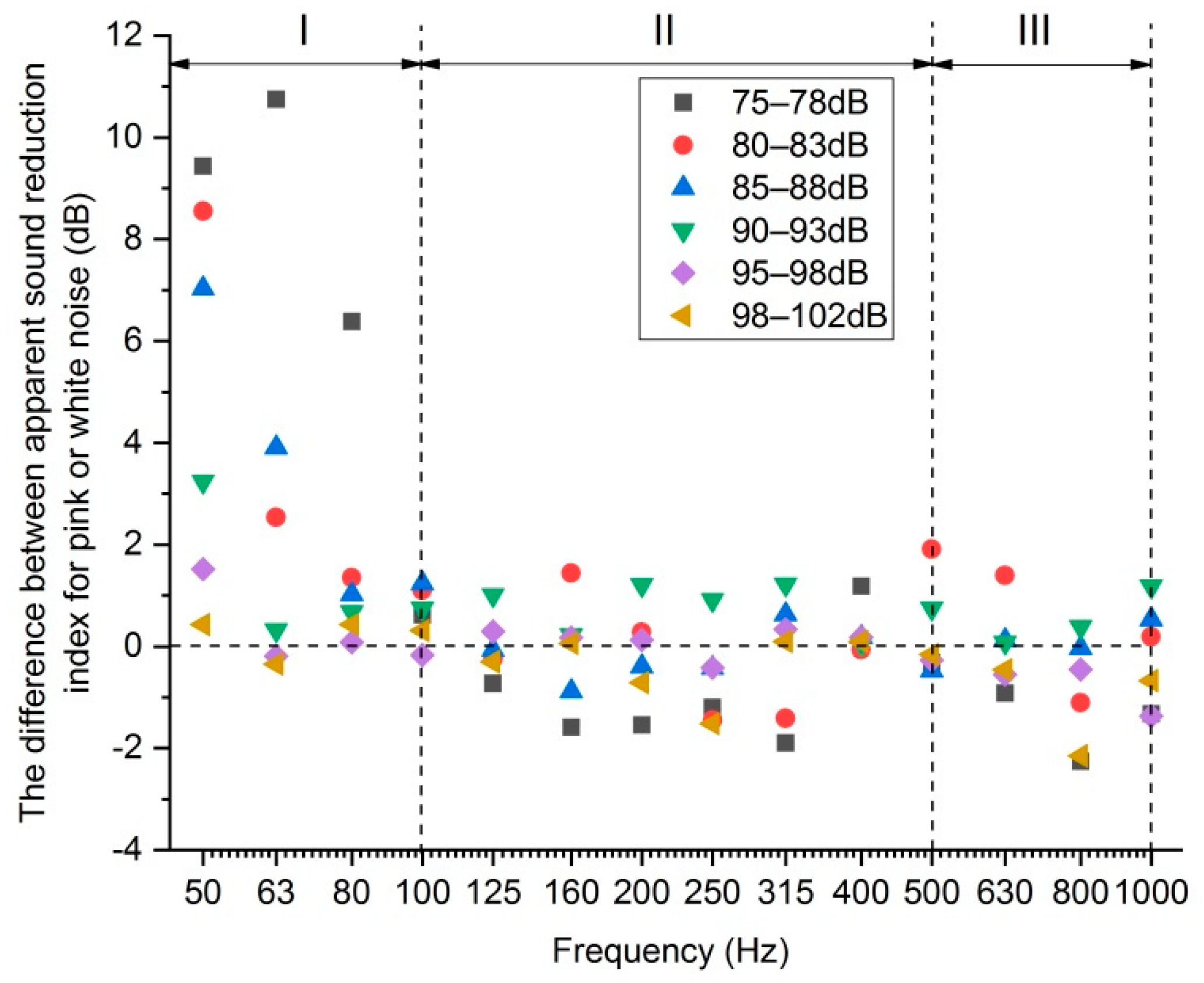

| Designation | Frequency (Hz) | Excitation Interval (dB) | Type of Noise |
|---|---|---|---|
| A | B | C | |
| Low (−) | F1 | 76 | White |
| High (+) | F2 | 100 | Pink |
| Frequency Interval (Hz) | Factors | |||
|---|---|---|---|---|
| A | B | C | ||
| I | effect | 18.190 | 8.675 | 5.075 |
| p-value | 0.003 * | 0.009 * | 0.049 * | |
| II | effect | 8.023 | 1.243 | −0.262 |
| p-value | 0.0001 * | 0.040 * | 0.583 | |
| III | effect | 4.258 | 0.382 | −0.117 |
| p-value | 0.0001 * | 0.146 | 0.610 | |
| b0 | b1 | b2 | r2*100% | |
|---|---|---|---|---|
| White | ||||
| Interval I | −26.54 | 0.255 | 0.316 | 84.3 |
| Interval II | 26.75 | 0.023 | - | 76.2 |
| Interval III | 29.59 | 0.009 | - | 87.6 |
| Pink | ||||
| Interval I | 3.428 | 0.171 | 0.082 | 78.2 |
| Interval II | 27.35 | 0.024 | - | 76.8 |
| Interval III | 30.03 | 0.008 | - | 71.8 |
| b0 | b1 | b2 | b3 | r2*100% | |
|---|---|---|---|---|---|
| Interval I | |||||
| Model IIa | −12.827 | 0.213 | 0.198 | 2.541 | 77.1 |
| Interval II | |||||
| Model IIb | 24.511 | 0.024 | 0.033 | - | 75.5 |
| Interval III | |||||
| Model IIc | 29.810 | 0.008 | - | - | 78.8 |
| Parameters | Frequency interval | ||
|---|---|---|---|
| Interval I | Interval II | Interval III | |
| Frequency | Changing the frequency value significantly affects the apaprent sound reduction index | Changing the frequency value significantly affects the apaprent sound reduction index | Changing the frequency value affects the apaprent sound reduction index |
| Excitation interval | Changing the excitation interval significantly affects the apaprent sound reduction index | Changing the excitation interval does not affect the apaprent sound reduction index | Changing the excitation interval does not affect the apaprent sound reduction index |
| Noise type | Changing the type of noise affects the apaprent sound reduction index | Changing the type of noise does not affect the apaprent sound reduction index | Changing the type of noise does not affect the apaprent sound reduction index |
Publisher’s Note: MDPI stays neutral with regard to jurisdictional claims in published maps and institutional affiliations. |
© 2020 by the authors. Licensee MDPI, Basel, Switzerland. This article is an open access article distributed under the terms and conditions of the Creative Commons Attribution (CC BY) license (http://creativecommons.org/licenses/by/4.0/).
Share and Cite
Lumnitzer, E.; Andrejiova, M.; Yehorova, A. Analysis of the Dependence of the Apparent Sound Reduction Index on Excitation Noise Parameters. Appl. Sci. 2020, 10, 8557. https://doi.org/10.3390/app10238557
Lumnitzer E, Andrejiova M, Yehorova A. Analysis of the Dependence of the Apparent Sound Reduction Index on Excitation Noise Parameters. Applied Sciences. 2020; 10(23):8557. https://doi.org/10.3390/app10238557
Chicago/Turabian StyleLumnitzer, Ervin, Miriam Andrejiova, and Anna Yehorova. 2020. "Analysis of the Dependence of the Apparent Sound Reduction Index on Excitation Noise Parameters" Applied Sciences 10, no. 23: 8557. https://doi.org/10.3390/app10238557
APA StyleLumnitzer, E., Andrejiova, M., & Yehorova, A. (2020). Analysis of the Dependence of the Apparent Sound Reduction Index on Excitation Noise Parameters. Applied Sciences, 10(23), 8557. https://doi.org/10.3390/app10238557





